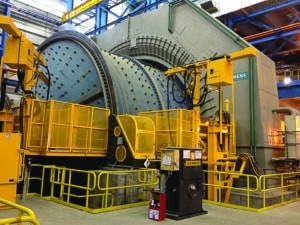Johnson Industries has the Australian mining industry’s braking needs covered.
As one of the leading global suppliers of industrial brakes, Johnson Industries knows what it takes to bring the mining sector’s biggest equipment to a stop.
Johnson brakes are fitted to semi-autogenous (SAG) and ball mills at some of the world’s largest mining operations, including copper, gold and iron ore mines in countries such as Australia, Chile, Mongolia, Indonesia and the US.
“We aim to optimise our brakes as much as possible,” Johnson head of sales Gil Sondraal told Australian Mining. “Whether that be a feature like double seals or a drain port, our mission is to make the product last as long as possible for the customer.
“We always say if we can make a break that requires no maintenance – that’s the optimal brake. And when we do need to do maintenance, we prioritise minimising downtime.”
Johnson’s mill lever brakes feature spring force compensation with a toggle link mechanism which allows for automatic wear adjustment within the working stroke range of the brake actuator.
“This maintains the required clamping force and torque regardless of the air gap, reducing intervals between brake adjustments,” Sondraal said.
“Direct acting brakes need to maintain their air gap to keep their torque rating. Air gaps are normally very small to achieve their clamping force, which results in premature lining wear as the flange moves due to run out and thermal growth of the mill.”

Johnson’s lower operating pressures enhance and prolong the seal and component life by allowing the use of standard hydraulic components and valves.
“The system is safer to operate, and leaks are less likely to occur,” Sondraal said. “Our brake release pressure is about 110 bar, which is about half the pressure of direct acting brakes.”
With a fewer number of actuators per mill, the need for actuator plumbing is reduced, decreasing the overall potential for leakage points.
This means less maintenance and adjustment, less often.
Direct acting brakes rely on float which increases wear and heightens the risk of downtime from material leakage from liner bolts.
With Johnson toggle levers forcing air gaps at both shoes, two drain lines at each actuator collect any minor oil leak, keeping the system and linings clean and operations running smoothly.
As an extra efficiency measure, lever pins rotate in needle bearings with wiper seals to minimise friction and the need for servicing.
“Our TL Series toggle lever brakes are the largest known spring-applied, hydraulic-released caliper brakes in the world,” Sondraal said. “They are particularly well-suited to accommodate very high braking torque requirements in the harshest mining environments.”
Johnson toggle lever brakes use a stackable design, which allows up to four calipers to be mounted in a common frame. From there, a constant braking torque is achieved through the unique toggle mechanism’s spring force compensation.
The caliper’s shoes are attached with stainless steel pins that incorporate countersunk lubricating holes, tapped pin-pulling holes and a pin retention groove.
The system is then powered by a hydraulic unit which incorporates a manifold fitted with two D10 valves to accommodate brake set, creeping and inching modes.
Johnson TL brakes are ideal for SAG mills and rock crushers, powered and controlled by Johnson’s three-mode hydraulic power units, which allow for set, creeping and inching capabilities.
“Johnson TL brakes together with a conveyor hydraulic unit that requires high torque braking makes for a powerful combination,” Sondraal said. “We recently fitted out an 8000-tonne-per-hour, 1402m belt with a drop over 259m with great success.”
Adaptability in the face of a challenge comes naturally to Johnson Industries, bolstered by decades of experience and a refined offering of mill and toggle brakes primed to meet the needs of any challenge.
According to Sondraal, the choice is obvious: “We’re a one-stop shop for the best conveyor brake solution.”
This feature appeared in the February 2024 issue of Australian Mining.




